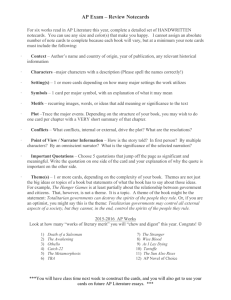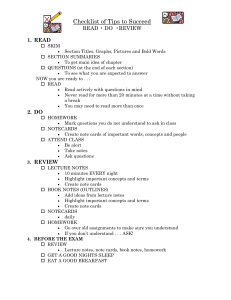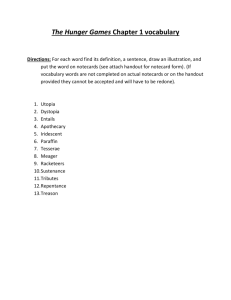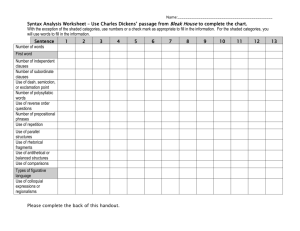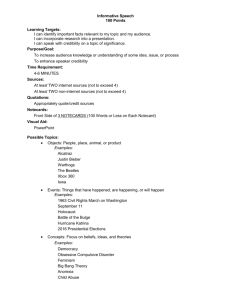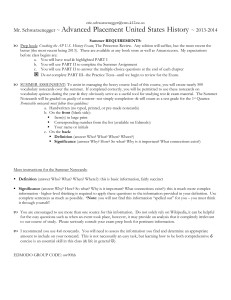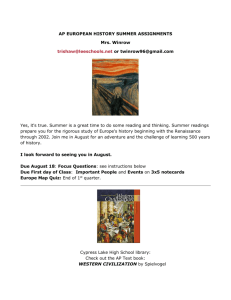English 9 Study Guide: Fall Semester Final 2015
advertisement
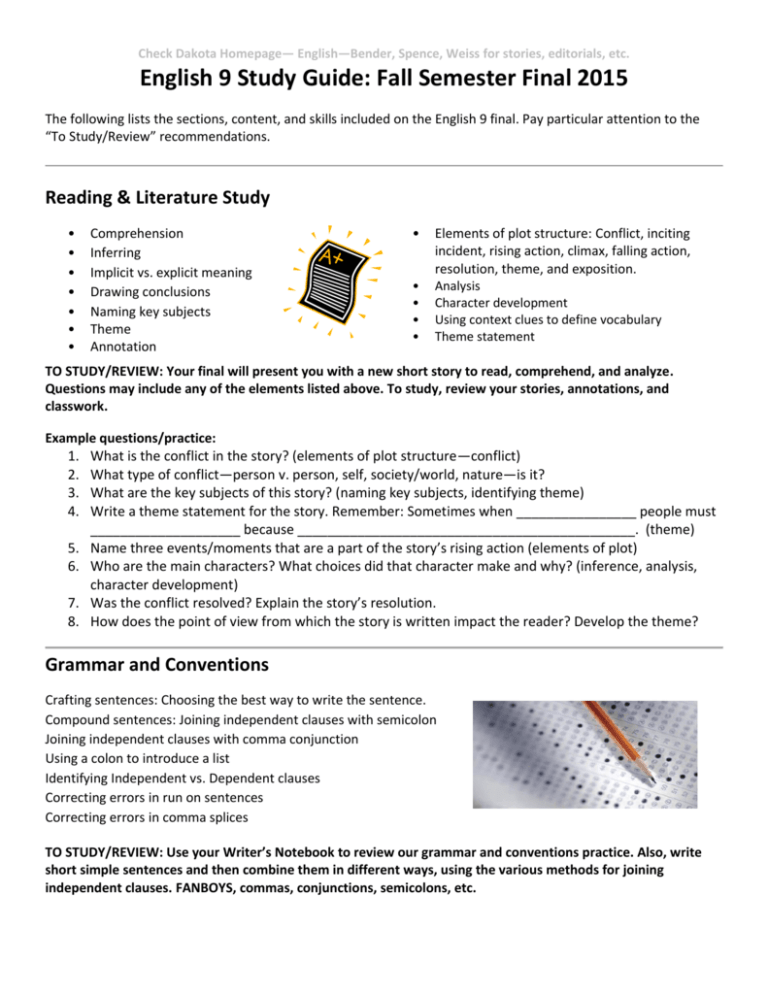
Check Dakota Homepage― English―Bender, Spence, Weiss for stories, editorials, etc. English 9 Study Guide: Fall Semester Final 2015 The following lists the sections, content, and skills included on the English 9 final. Pay particular attention to the “To Study/Review” recommendations. Reading & Literature Study • • • • • • • Comprehension Inferring Implicit vs. explicit meaning Drawing conclusions Naming key subjects Theme Annotation • • • • • Elements of plot structure: Conflict, inciting incident, rising action, climax, falling action, resolution, theme, and exposition. Analysis Character development Using context clues to define vocabulary Theme statement TO STUDY/REVIEW: Your final will present you with a new short story to read, comprehend, and analyze. Questions may include any of the elements listed above. To study, review your stories, annotations, and classwork. Example questions/practice: 1. What is the conflict in the story? (elements of plot structure—conflict) 2. What type of conflict—person v. person, self, society/world, nature—is it? 3. What are the key subjects of this story? (naming key subjects, identifying theme) 4. Write a theme statement for the story. Remember: Sometimes when ________________ people must ____________________ because _____________________________________________. (theme) 5. Name three events/moments that are a part of the story’s rising action (elements of plot) 6. Who are the main characters? What choices did that character make and why? (inference, analysis, character development) 7. Was the conflict resolved? Explain the story’s resolution. 8. How does the point of view from which the story is written impact the reader? Develop the theme? Grammar and Conventions Crafting sentences: Choosing the best way to write the sentence. Compound sentences: Joining independent clauses with semicolon Joining independent clauses with comma conjunction Using a colon to introduce a list Identifying Independent vs. Dependent clauses Correcting errors in run on sentences Correcting errors in comma splices TO STUDY/REVIEW: Use your Writer’s Notebook to review our grammar and conventions practice. Also, write short simple sentences and then combine them in different ways, using the various methods for joining independent clauses. FANBOYS, commas, conjunctions, semicolons, etc. MORE IDEAS: Visit Purdue OWL’s website and work through available exercises and practices. All answer keys are linked to the bottom of the pages. Purdue OWL Exercises website • JOINING INDEPENDENT CLAUSES: Comma-conjunction vs. semicolon • Independent vs. Dependent clauses • Correcting Run-ons & Comma Splices Word Study & Parts • • Suffixes: Know their definitions How suffixes create/change parts of speech TO STUDY/REVIEW: Try creating online notecards using Quizlet! It’s fun, so do it! OR…use your notecards to study/prep for the final, OR your notecards/use the Word Parts List for study. To take your study a step further, add to your notecards: Write a sentence that correctly uses a word including that word part, make a list of words that use that word part, draw a more in-depth picture to help you remember that word part’s meaning, and/or meet with a friend and quiz each other on the word parts. Suffix -ize Meaning Part of Speech Examples Alphabetize, socialize, legalize -ate Fixate, activate, motivate -ing Running, thinking, being -ist Artist, scientist -ism Racism, socialism -ment Basement, judgment -ation, -tion Education, institution -tude Attitude, rectitude -er,-or Runner, teacher, reader -able, -ible Capable, possible -ic Scientific, horrific -ly Quickly, invisibly -ward, -ways, wise Toward, sideways, crosswise PEAL Paragraph TO STUDY/REVIEW: Know what each of the pieces of a PEAL paragraph are and how to identify them in a written paragraph. Editorial Elements of argument: CLAIM, COUNTERCLAIM, EVIDENCE, REASONING, CALL TO ACTION Author’s purpose Analysis Using context clues to define difficult vocabulary Inferring Rhetorical appeals: ethos, pathos, logos Vocabulary from Editorial vocabulary list TO STUDY/REVIEW: Gather the editorials and arguments we’ve read in class, or new ones from your teacher’s website, and annotate them for the information above. Make a Quizlet to study the vocab OR use your notecards to study the vocabulary, OR create notecards for study. Meet with a friend/classmate to quiz each other on the vocabulary and to talk through the elements of editorial/argument in the readings. Example questions: 1. What is the author’s CLAIM? (argument, claim) 2. How does the author make the reader care about the subject? (appeals, pathos) 3. How does the author establish her/himself as a credible, trustworthy source of information? (ethos) 4. What is the author’s purpose in writing this editorial? (author’s purpose, analysis) 5. Circle words you’re finding challenging, and look in the sentence for context clues that hint at the word’s meaning. Write your best guess at the word’s definition. (vocabulary in context) 6. Find and label examples of the vocabulary words in the chart on the next sheet. 7. What is the author’s call to action? 8. What type of evidence does the author use to support her/his claim? Is it effective? (argument, evidence, logos) Test yourself on these words: Call to Action Ethos Pathos Logos Claim Counterclaim Fallacy Appeal Evidence Prejudice
